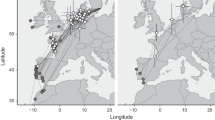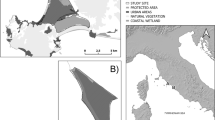Summary
In order to test the potential influence of short wave radiation on the homing behaviour of pigeons we positioned two lofts with adult homing pigeons in the vicinity of a short wave transmitter. One loft was next to the transmitter and fully exposed to the radiation, the second protected against the radiation (a) by topographical features and (b) by its position in a sector that was not used for transmission during daytime. In both lofts young pigeons were raised and used for experimental flights at the age of three months. Adults accustomed to the new sites as well as young birds from the exposed and non-exposed lofts, respectively, were released some 11 km from the loft for homeward flights towards the transmitter, with and without transmission towards the relevant sector.
Vanishing direction and vanishing time were not affected by the short wave radiation in any of the groups, thus corroborating earlier experiments with pigeons flying homewards from the transmitter towards distant lofts. However, all three groups raised in the absence of short wave radiation (A−, A+, J−) homed tendentially faster in situations where radiation was absent compared to situations with radiation. Pooled in one data set the three groups were significantly faster without radiation. On the other hand, the two juvenile groups raised under radiation (J1+ and J2+) homed at the same speed under both short wave situations. Furthermore, all five groups tended to choose lower flight altitudes when released under the influence of short wave radiation (significantly when groups were pooled). Besides the experiments, observations near the loft gave the impression that the pigeons kept in the exposed loft were reluctant to fly in the neighbourhood of the loft, particularly the adults.
We conclude that short wave radiation can be felt by the pigeons, but does not interfere with their initial orientation. Reduced homing speeds of birds grown up without experiencing radiation, low flight levels in flights under radiation in all groups, and a general reluctance to fly of the pigeons next to the exposed loft, suggest that the radiation has an undefined negative effect on the birds. Unimpaired homing speeds in juveniles having grown up under varying field strengths suggest that homing pigeons can become accustomed to short wave radiation to a certain extent.
Zusammenfassung
Um den potentiellen Einfluß von Kurzwellen auf die Orientierung und das Heimkehrverhalten von Brieftauben zu testen, wurden zwei Schläge in der Nähe eines Kurzwellensenders eingerichtet, der eine der Strahlung voll ausgesetzt, der anderer in einem tagsüber nicht für Sendungen benutzten Sektor und zudem topographisch gegen den Sender geschützt. In beiden Schlägen wurden Jungtauben aufgezogen und im Alter von drei Monaten für Testflüge genutzt. Die mit bzw. ohne Kurzwellen am neuen Standort angewöhnten Alttauben sowie die mit bzw. ohne Kurzwellen an diesem Standort aufgewachsenen Jungtauben wurden von einem etwa 11 km entfernten Auflaßort für Heimflüge gegen den Sender mit und ohne Kurzwellen-Einfluß im relevanten Sektor eingesetzt.
Es ergaben sich keine Unterschiede in der Anfangsorientierung zwischen den Versuchsgruppen. Dagegen flogen alle ohne Kurzwellen-Einfluß aufgewachsenen Gruppen tendenziell rascher heim, wenn kein aktueller Kurzwellen-Einfluß vorhanden war. Faßte man alle drei Gruppen zusammen, so wurde dieser Unterschied signifikant. Demgegenüber zeigten die beiden mit Strahlung aufgewachsenen Gruppen unter den beiden Strahlungsbedingungen keine unterschiedlichen Heimkehrgeschwindigkeiten. Die fünf Testgruppen zusammengefaßt zeigten geringere Flughöhen unter Kurzwellen-Einfluß. Diese Ergebnisse lassen darauf schließen, daß die Brieftauben die Kurzwellen fühlen können, daß aber ihre Anfangsorientierung dadurch nicht beeinträchtigt wird. Reduzierte Heimkehrgeschwindigkeiten und geringe Flughöhen unter Kurzwellen-Einfluß, deuten auf einen störenden Effekt der elektromagnetischen Felder hin. Das Verhalten der unter Kurzwellen aufgewachsenen juvenilen Gruppen erlaubt den Schluß, daß sich Tauben an gewisse Kurzwellenbedingungen gewöhnen können.
Similar content being viewed by others
Literatur
Batschelet, E. (1981): Circular Statistics in Biology. New York.
Beason, R.C., Dussourd, N. & Deutschländer, M.E. (1995): Behavioural evidence for the use of magnetic material in magnetoreception by a migratory bird. J. exp. Biol. 198: 141–146.
Boldt, A. & Bruderer, B. (1994): Anfangsorientierung von Brieftauben im Einflußbereich eines Kurzwellensenders. Ornithol. Beob. 91: 111–123.
Bruderer, B. (1992): Radar studies on bird migration in the south of Israel. Bird Strike Comm. Europe 21: 270–280, Jerusalem.
Bruderer, B. & Boldt, A. (1994): Homing Pigeons under Radio Influence. Naturwissenschaften 81: 316–317.
Drost, R. (1949): Zugvögel perzipieren Ultrakurzwelle. Vogelwarte 2: 57–59.
Eastwood, E. (1967): Radar ornithology. London.
Eastwood, E. & Rider, G.C. (1964): The influence of radio-waves upon birds. Brit. Birds 57: 445–458.
Foà, A., Benvenuti, S., Ioalè, P. & Wallraff, H.G. (1984): Geographical and temporal variability in pigeon homing. Parallel studies in Italy and Germany. Behav. Ecol. Sociobiol. 15: 25–34.
Hild, J. (1971): Beeinflussung des Kranichzuges durch elektromagnetische Strahlung? Wetter und Leben 23: 45–52.
Hirsiger, H. & Wagner, G. (1968): Vergleich der Orientierungs-und Heimkehrleistungen verschiedener Altersgruppen von Brieftauben. Rev. Suisse Zool. 75: 589–597.
Ioalè, P. & Guidarini, D. (1985): Methods for producing disturbances in pigeon homing behaviour by oscillating magnetic fields. J. exp. Biol. 116: 109–120.
Ioalè, P. & Teyssèdre, A. (1989): Pigeon homing: effects of magnetic disturbances before release on initial orientation. Ethol. Ecol. & Evol. 1: 65–80.
Keeton, W.T. (1971): Magnets interfere with pigeon homing. Proc. Nat. Acad. Sci. USA 68: 102–106.
Keeton, W.T. (1974): The orientational and navigational basis of homing in birds. Adv. in the study of behaviour 5: 47–132. New York.
Kleinhaus, S., Pinshow, B., Frumkin, R., Ruppin, R. & Margaliot M. (1995): Thermal effects of short radio waves on migrating birds. Ecol. applic. 5: 672–679.
Knorr, O.A. (1954): The effect of radar on birds. Wilson Bull. 66: 264.
Kreithen, M.L. (1978): Sensory mechanisms for animal orientation — can any new ones be discovered? In: Schmidt-Koenig, K. & Keeton, W. T. (eds): Animal migration, navigation and homing: 25–34. Berlin.
Kreithen, M.L. & Keeton, W.T. (1974): Detection of changes in atmospheric pressure by the homing pigeon, Columba livia. J. comp. Physiol. 89: 73–82.
Neitzke, H.P., van Capelle, J., Depner, K., Edeler, K. & Hanisch, T. (1994): Risiko Elektrosmog? Auswirkungen elektromagnetischer Felder auf Gesundheit und Umwelt. Basel.
Papi, F. & Ioalè, P. (1986): Pigeons homing: effect of oscillating magnetic fields during flight. Atti. Acc. Lincei Rend. Fis. 80: 426–434.
Quine, D.B. (1982): Infrasounds: A potential navigational cue for homing pigeons. In: F. Papi & Wallraff, H.G. (eds): Avian navigation: 373–376. Berlin.
Teyssèdre, A. (1986): Radio-tracking of pigeons previously exposed to random oscillating magnetic fields. Behaviour 96: 265–276.
Walcott, C. & Green, R.P. (1974): Orientation of homing pigeons altered by a change in the direction of an applied magnetic field. Science 184: 180–182.
Wiltschko, R. (1992): Das Verhalten verfrachteter Vögel. Vogelwarte 36: 249–310.
Wiltschko, W. & Wiltschko, R. (1978): Evidence for the use of magnetic outward-journey information in homing pigeons. Naturwissenschaften 65: 112–113.
Wiltschko, W., Munro, U., Beason, R.C., Ford, H. & Wiltschko, R. (1994): A magnetic pulse leads to a temporary deflection in the orientation of migratory birds. Experientia 50: 697–700.
Author information
Authors and Affiliations
Rights and permissions
About this article
Cite this article
Steiner, I., Bruderer, B. Anfangsorientierung und Heimkehrverhalten von Brieftauben unter dem Einfluß von Kurzwellen. J Ornithol 140, 165–177 (1999). https://doi.org/10.1007/BF01653596
Accepted:
Published:
Issue Date:
DOI: https://doi.org/10.1007/BF01653596




